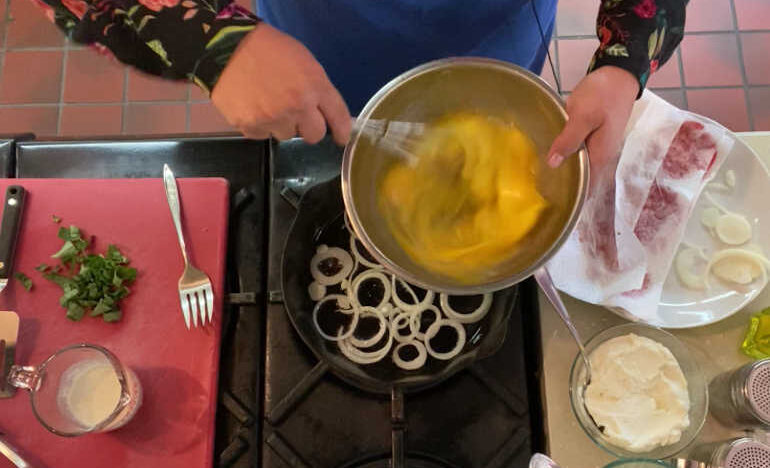The Frittata

By Lucia Ferrara
The frittata is an egg dish you can make by combining whatever vegetables and/or meat you have on hand. You can even use leftovers. Growing up, my mom would make a frittata for supper as either an appetizer or to serve with soup or salad. Sometimes when pasta was on the menu, she would have a frittata on the side.
A frittata is not an omelet. With an omelet, you put ingredients — generally raw, but sometimes cooked — on to a layer of eggs that already cooked and the eggs are folded over the ingredients. For the frittata, first, you sauté or steam the ingredients and then you pour the egg mixture over those ingredients so that they are all incorporated together.
Frittata
- 8-10 eggs
- ½ onion, sliced
- 1 tomato, sliced
- Fresh basil
- ½ cup grated hard cheese (parmesan, asiago or pecorino romano)
- 6-8 tablespoons ricotta cheese
- ¼ cup whipping cream
- Olive oil
- Salt and pepper to taste
- Pinch of baking soda
Preheat oven to 350 degrees. Use an oven-safe skillet.
The milk or cream isn’t essential in the frittata, but using it turns the eggs into almost a custard and gives the dish light and fluffy. My secret ingredient is baking soda. Adding a pinch of baking soda to the eggs just before you add them to the skillet will help the dish rise, thicken it and add to that creamy-smooth texture.
I use a cast-iron skillet because that is what I like, but you don’t have to. You do need a skillet that can sauté ingredients on the stovetop and then can be baked in the oven. So it doesn’t have to be cast iron, but it has to be oven safe.
Cooking as a spiritual practice
This is a great dish to serve as an appetizer or side dish at dinner. Served with toast, it makes for a fresh, hearty breakfast.
This is a dish I grew up with. My dad liked it with kielbasa and potatoes. Sometimes my mom would use kielbasa and green peppers. One lady from our parish would make frittatas every year for St. Joseph’s Day celebration. She’d make a cauliflower frittata and a broccoli frittata — wonderful! Sometimes for a specialty one, she would make an asparagus frittata. That was one of my favorites.
Never miss an article published on the Renewal Center website: Sign up to receive our newsletters.
Cooking for me has become a spiritual practice. I learned a lot from my mom growing up and I have a few of her recipes written down that I can actually hold and touch. But the ones that really resonate with me are the ones I hold in my heart, that I learned with her when we would cook together in the kitchen or just by watching her or by listening to her stories of her and her mother cooking.
One thing about my mother’s style of cooking that inspires me is how she was empowered by God’s perspective of love, of kindness and hospitality. You know, that goodness within you that comes out in the taste of the dish that you make. I’ve embraced that same idea, that same practice, that I learned from my mom. It helped me to understand better who she was. It also helped me understand where I came from and it helps me understand who I am.
So with that being said, I hope that you enjoy your frittata with a friend or a family member, and remember to embrace love, kindness, and hospitality in all that you do every day.
All the articles and videos in the Cooking and Spirituality Series can be found here.
[Lucia Ferrara, the Director of Hospitality at Precious Blood Renewal Center. Share your thoughts with Lucia or ask her questions using the form below or by sending an email to info@pbrenewalcenter.org.]
Related

Pilgrims of Hope, Episode 6: Walking with Cancer Survivors
Hosted by Fr. Ron Will, C.PP.S.
We are talking with people who find hope amid difficult circumstances or bring hope to others. In this episode, Kathy Keary talks about how centering prayer, journaling and other spiritual practices helped her cope with two life threatening health issues.

The Rollercoaster Torture
An Assembling God’s Puzzle video
By Fr. Garry Richmeier, C.PP.S.
Life is full of ups and downs, like a roller coaster, and that fact is a piece of life’s puzzle that we must deal with. Depending on how we deal with it, it can be torture, or it can be simply another difficult aspect of life to be navigated. How do we avoid the torture?
Categories
Assembling God's Puzzle Coffee with Padre Cooking & Spirituality Encounters of the 4th Kind Family Matters Reflections on the Eucharsitic Prayers Spiritual Resources Taize Prayers The Contemplative Life Traveling with Pilgrims of Hope Uncategorized Videos Week of Prayer for Uhristian Unity When you need a little help
